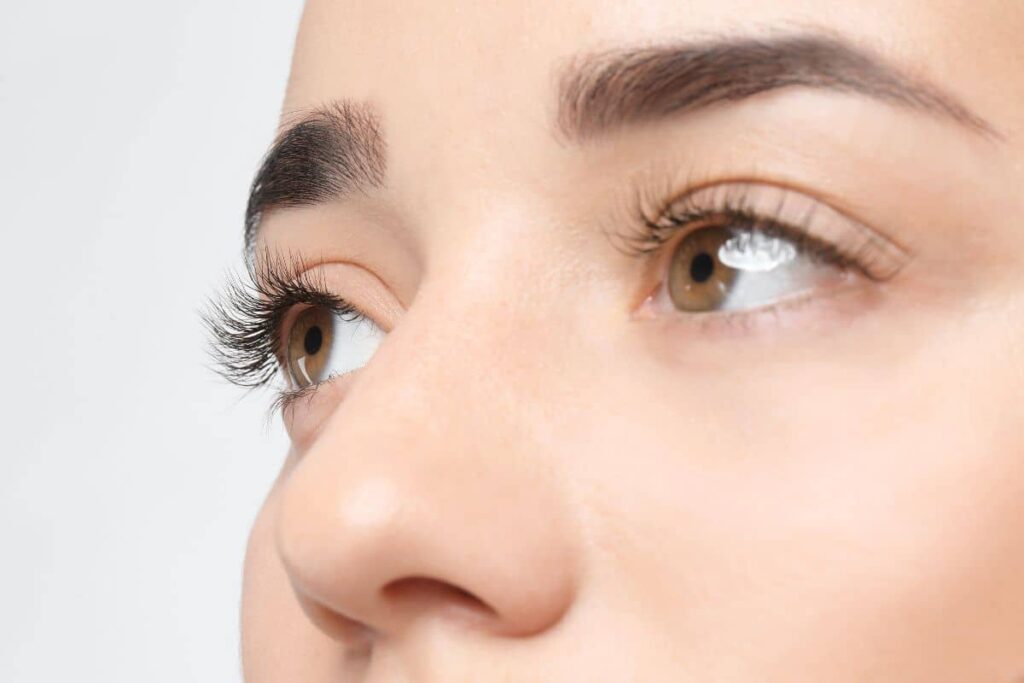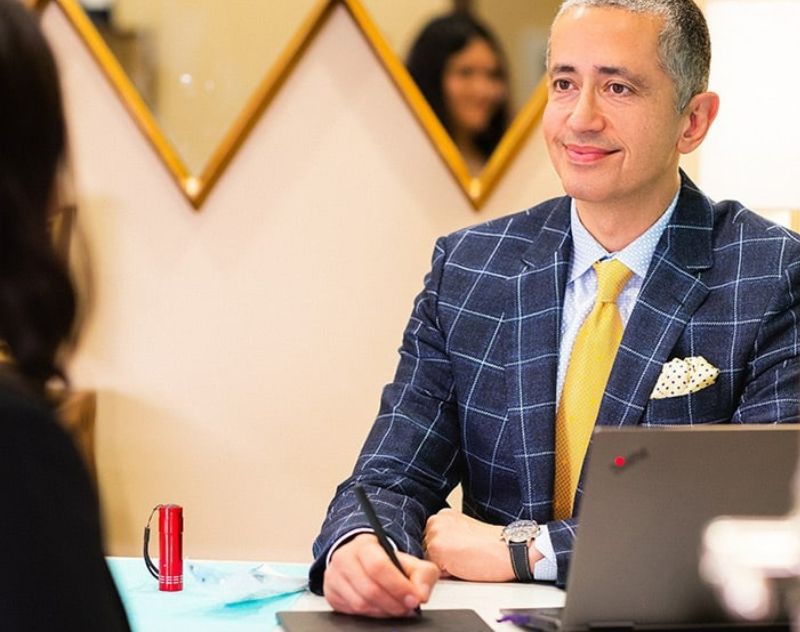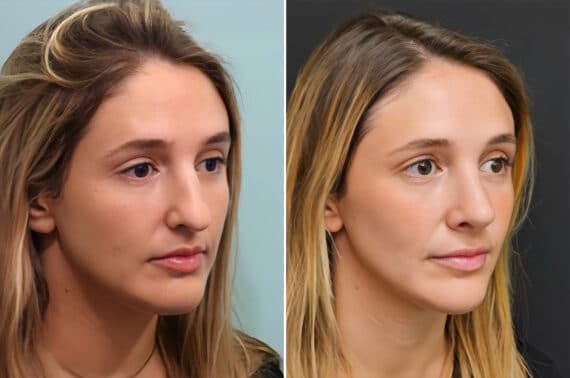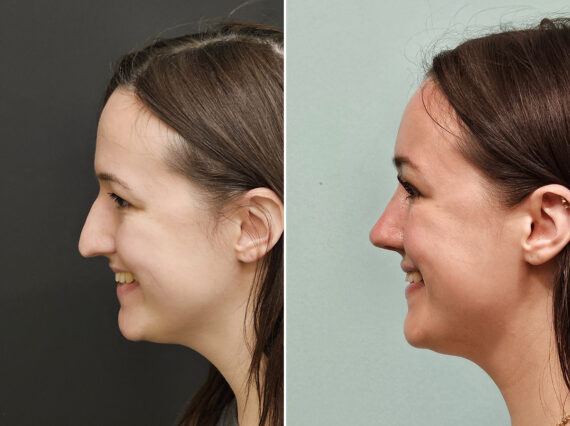When it comes to rhinoplasty, the goal is not simply removing cartilage and bone from the nose but to refine, reshape or enhance it while maintaining natural structure important for long term results. A modern method now draws notice worldwide—preservation rhinoplasty. Surgeons who use it leave most of the nose’s own bone and cartilage intact as much as possible.
At The Naderi Center for Plastic Surgery and Dermatology, Dr. Shervin Naderi, a double Board-Certified Facial Plastic Surgeon and an ENT surgeon, offers “Hybrid Rhinoplasty,” a truly revolutionary approach in rhinoplasty, combining both preservation rhinoplasty and structural rhinoplasty. Hybrid rhinoplasty blends the best of both worlds, combining the principles of preservation with the added long term benefits of structure to refine and elevate results with minimized trauma, reduced downtime, and a natural, balanced outcome.

What Makes the Preservation Rhinoplasty Procedure Different?
- Preservation rhinoplasty changes the shape of the nose, but it keeps the original framework and character.
- The method reduces swelling and bruising as well as the time needed to heal—the recovery feels easier.
- Dr. Naderi uses a hybrid method that mixes preservation work with structural support to give both a good appearance and function.
- Each operation is planned to fit the patient’s features but also the goal of who undergoes it.
- When a patient chooses a seasoned rhinoplasty specialist like Dr. Naderi, the outcome looks natural, stays balanced, and endures for years.
What Is “Preservation Rhinoplasty?”
Preservation rhinoplasty is a very old principle that regained traction in the modern-day nose job arena by reminding plastic surgeons the importance of leaving as much native nose structure intact and avoiding destructive “reductive rhinoplasty” methods of the past few decades. Preservation rhinoplasty has come to be synonymous with modern surgical techniques designed to reshape the nose while preserving the soft tissue, ligaments, and key nasal structures, especially along the dorsum (the bridge of the nose).
Preservation vs. Traditional Rhinoplasty

Unlike traditional rhinoplasty, which often involves removing bone and cartilage from the top of the nasal bridge (commonly known as ‘hump removal’), preservation rhinoplasty works by modifying the nose from underneath, lowering the nasal bridge while leaving the top surface mostly intact. This creates a smoother, more natural contour reducing chances for sharp edges or the risk of visible irregularities on the bridge.
As Dr. Naderi explains, “Preservation rhinoplasty is not about doing less—it’s about doing things differently. It’s about achieving the same goals of refinement and balance, but with a different approach that respects the patient’s natural anatomy.”
Historical Roots and Modern Revival
The idea of preservation rhinoplasty is not new. Surgeons in France and Spain began to use it in the early 20th century. They kept most of the nose’s own architecture, so the result still looked like the patient’s nose. New tools and a clearer grasp of nasal anatomy have brought the method back. A number of leading rhinoplasty surgeons now choose it again.
Dr. Shervin Naderi: Rhinoplasty Expert Surgeon with 20+ Years of Experience
Dr. Shervin Naderi stands out among nose surgeons in the United States because he works on nothing except noses. During the past twenty years, he has carried out thousands of nose operations and has learned many methods so that each individual receives a result that fits their natural features. He changes and sharpens his methods every year because he refuses to settle for less than the best result. He has full mastery of both open and closed nose job techniques. His double board certification in facial plastic surgery and otolaryngology (ENT) gives him a unique advantage. Many plastic surgeons care only about how the nose looks; Dr. Naderi is also highly skilled in functional nasal surgery. When a patient needs that kind of repair, part of the operation sometimes qualifies for payment by an insurance company.
At The Naderi Center, Dr. Naderi does not believe in only one surgical approach for all patients. He picks the exact method that fits one patient. If a nose needs preservation rhinoplasty, he uses that—if it needs traditional structural work, he will work with that. Some noses need the open approach, some need the closed or scarless rhinoplasty. His goal stays the same: the nose must look real, work well and stay fixed for life.
Who Is an Ideal Candidate for Preservation Rhinoplasty?
The technique suits only some people, and that is fine. It gives the most predictable result when the nose already shows:
- Ideal Brow-tip aesthetic lines
- A dorsal hump that is prominent but structurally suited for preservation
- Good skin elasticity
- Minimal prior nasal trauma or surgery
Preservation rhinoplasty suits first-time patients who want only a small, natural change, not a big one. Dr. Naderi reshapes the nose yet leaves its original character intact—perfect for patients who say, ‘I don’t want a new nose; I want a better version of my nose.’
When Traditional Rhinoplasty Surgery Is Still Necessary
Preservation nose surgery helps many patients, but it does not suit every case. The traditional method remains the better choice if the nose shows any of the following:
- Severe trauma or a broken nose
- Previous surgeries requiring revision rhinoplasty
- Complex tip reshaping needed
- Thick skin with poor elasticity
- Severe asymmetries
In these cases, standard rhinoplasty is not ‘worse’—it’s simply the right tool in the surgeon’s toolbox. As Dr. Naderi explains, “Sometimes the best approach is preservation. Other times, the safest and most predictable outcome comes from traditional structural rhinoplasty. It’s about knowing which technique will serve the patient best—not forcing one method on everyone.” But for most patients, Dr. Naderi utilizes his unique “Hybrid Rhinoplasty” approach which combines the best of both worlds.
Rhinoplasty on a patient with a dorsal hump and tip asymmetries.

Trust your nose to a true specialist.
Schedule a one-on-one consultation with Dr. Naderi to discuss your customized rhinoplasty plan.
Risks and Limitations of the Preservation Nose Job
As with any surgical procedure, preservation rhinoplasty carries risks, including:
- Incomplete hump correction or hump recurrence if the patient’s anatomy is not ideal for the technique
- The potential need for revision in rare cases
- Persistent asymmetries if the nose was significantly crooked to begin with
- Limitations in making extreme aesthetic changes
That’s why choosing a highly experienced ultra-specialized plastic surgeon like Dr. Naderi is crucial. He will give each patient an honest assessment during consultation, ensuring realistic expectations. He does not use these terms for marketing purposes. He uses “Ultrasonic rhinoplasty” in select patients but does not advertise it to all. He uses “preservation” for select patients but does not brag about it online as a marketing tool. He will devise and carry out the best surgery for each patient’s unique nose.
The Naderi Center’s Superior Recovery Protocol
Dorsal preservation, tip rotation with improved support, osteotomies and septoplasty to bring the nose closer to the facial midline.
One of the hallmarks of The Naderi Center is a recovery plan for nose surgery that aims to reduce bruises, puffiness and pain. Patients who choose either the preservation method or the structural method receive the same careful aftercare.
- An anti-bruising, anti-bleeding diet starting two weeks before surgery
- Arnica supplements to reduce postoperative bruising and inflammation
- A low-dose steroid regimen to accelerate healing and minimize swelling
- Taping protocols to help guide the healing process
- Strict lifestyle modification instructions to prevent complications
As Dr. Naderi emphasizes, “Surgery is just one part of the journey. How you heal and recover is just as important as how well the surgery is performed. That’s why our patients follow a meticulous recovery plan designed to give them the best possible outcome.”
Timing Is Everything: Why Dr. Naderi Encourages Patience
Unlike some cosmetic practices, Dr. Naderi does not push anyone toward surgery. He asks each person to book a rhinoplasty only after the person decides to accept the daily changes that come before and after the operation, as those changes help the nose heal well and keep the result stable. He also requires his patients to understand how long healing takes and to stay active in the recovery process by following every step of his clear, thorough list of instructions that covers the days before and after the procedure.
Why The Naderi Center?

People travel to The Naderi Center from every state and from many countries because of Dr. Naderi’s specialization and surgical expertise. He is not a Jack of all trades plastic surgeon; he exclusively performs one surgery – rhinoplasty. This laser-focused practice model allows him to stay on the cutting edge of techniques like preservation rhinoplasty while offering unparalleled skill in traditional and revision rhinoplasty when necessary.
Schedule Your Consultation
If you think about a nose job and want to know if a preservation or hybrid method suits you, book a visit with Dr. Shervin Naderi at The Naderi Center in Chevy Chase, Maryland or Reston, Virginia. He holds two board certificates, knows how to fix both breathing and appearance and treats each patient with honest, kind attention — you place yourself under one of the country’s leading nose doctors.
Preservation Rhinoplasty FAQs
How is preservation rhinoplasty different from traditional rhinoplasty?
Traditional methods often remove bone/cartilage from the bridge (“hump removal”). Preservation reshapes from underneath to lower the bridge while keeping the top surface largely intact, helping maintain smooth, natural bridge lines. When needed, Dr. Naderi blends preservation with structural techniques (Hybrid Rhinoplasty) for the safest, most predictable outcome.
Can preservation rhinoplasty fix a crooked nose or breathing issues?
It can address select crooked noses and functional concerns, but complex deviations or severe asymmetry may require structural rhinoplasty techniques. As a double board-certified Facial Plastic Surgeon and ENT, Dr. Naderi can address both form and function—and parts of functional correction may be insurance-eligible.
What results should I expect? Subtle or dramatic?
Preservation favors subtle, natural refinement. If your goals involve major reshaping, Dr. Naderi may recommend a hybrid or structural plan to achieve safe, lasting results.
What is Hybrid Rhinoplasty and why might I need it?
Hybrid Rhinoplasty uses two approaches at once — it keeps parts of the nose that work well plus rebuilds parts that need help. Dr. Naderi keeps healthy tissue when it serves a purpose and adds grafts or supports when the tip droops, there is asymmetry or old injuries have left the nose weak. The goal is a nose that looks normal, stays firm but also allows reliable breathing.
Can thick skin limit my results?
Thicker skin can blunt fine definition, especially at the tip. Dr. Naderi will discuss realistic expectations and may recommend hybrid/structural support to maximize definition where appropriate.
I’ve had a previous rhinoplasty. Can preservation still help?
Revision noses often have disrupted anatomy, making pure preservation less suitable. Hybrid or structural strategies are more commonly used in revisions. You’ll get a candid assessment during consultation.

